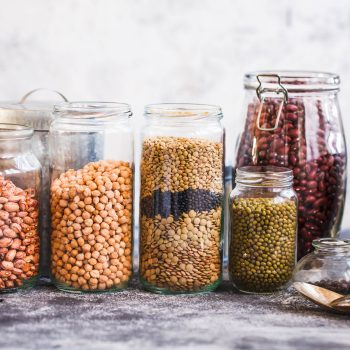The right amount of protein is essential to keep your body healthy. Protein contributes to the structural turnover of the body, muscle mass, skin attachments (skin, hair, nails), as well as promoting the transport of nutrients, being part of enzymes that activate metabolism of the organisms and not forgetting that the immunoglobulins essential for the immune response, are made of protein. Protein is an energy and plastic energy source, compared to carbohydrates and lipids that are only an energy source. We know how the loss of muscle mass, defined in recent years as sarcopenia, characterized by loss of mass and muscle strength, is now considered a risk factor for the onset of cardiovascular disease, metabolic syndrome, dementias, and autoimmune diseases. We talk about this topic with Dr. Laura Maria Anna Carabelli, dietitian at Humanitas.
An essential macronutrient
Proteins are macromolecules made up of amino acids, constituent elements of lean tissue (muscle mass, bone, skin attachments). They are divided into animal proteins (meat, eggs, fish, milk) with a high nutritional value because they contain all the essential amino acids and vegetable proteins (legumes, cereals, dried fruit), considered incomplete because they lack an amino acid defined as limiting. Many experts say that most of the proteins should be taken through food, but that it is possible to supplement with protein supplements in case of increased needs (physical activity, anorexia, cachexia, malabsorption by gastroenteric diseases) or low dietary intake. However, not all protein supplements are the same. Before analyzing the pros and cons of different protein sources it is important to understand which types of protein supplements they can be divided into.
The right quantities
The amount of protein required by the body is calculated on the basis of body weight, physical activity and, above all, clinical conditions. We have seen how it is necessary to increase the intake in case of intense physical activity, but also pathologies such as malabsorption or neoplastic cachexia, for example. In general we recommend an intake of 0.8-0.9 gr per kg per day. The need increases to 1.2 gr up to 2 gr per kg for athletes. The distribution of proteins is divided into meals or after training, in order to optimize absorption and use at the plastic energy level, it is not recommended to exceed 30-35 grams of protein per meal, maximum dose of absorption per meal.
1 “Isolated” protein concentrate
Isolated proteins are obtained through a more elaborate and innovative process, so as to separate the protein component from the other lipid, mineral and lactose components as much as possible, so as to obtain an amino acid content of up to 90-95% (compared to other pure protein powders which have a lower percentage of 70-85% amino acids with a fat and carbohydrate content of 30-15%).
2 Complete and incomplete proteins
Amino acids that cannot be synthesized by the body are known as essential amino acids. “Complete” proteins contain all 8 essential amino acids, histidine is also essential in children, and “incomplete” proteins lack one or two essential amino acids, which are called limiting amino acids. Cereals are in fact deficient in lysine as a limiting amino acid while legumes are deficient in methionine, considered a limiting amino acid.
Supplements, how to orient around them?
Let’s see in detail how many and which types of supplements exist, analyzing their pros and cons.
Whey protein
“Whey protein” is a protein powder mix obtained from whey or buttermilk, particularly rich in proteins, with a high biological value. Given the presence of a high content of branched amino acids, excellent presence of essential amino acids, serum proteins that promote recovery after training, stimulate protein synthesis and muscle growth, thus promote, in a proper diet and lifestyle, the recovery of muscle mass and fat loss, ultimately promoting cardiovascular health.
Cons: the sugar present in milk (lactose) can create problems of lactose intolerance in some people with the appearance of colitis and swelling after intake. There are different types of whey proteins; a product is defined as high quality if it has a high protein content and low lactose content.
Casein protein
Casein is produced by ultrafiltration. It has a slower absorption time than serum proteins for a longer digestive process. This allows you to recommend serum proteins for protein synthesis and muscle recovery, casein to prevent muscle degradation (catabolism).
Cons: Casein is a milk by-product with a more allergenic effect and less indicated in post-workout, as it is absorbed more slowly.
Egg protein
The egg protein, obtained by separating the egg whites (excellent protein source) from the yolk (which in addition to proteins also contains the lipid component and cholesterol), is an excellent alternative to whey proteins. In addition to proteins, in the egg we also find mineral salts such as potassium, sodium and magnesium and B vitamins.
Cons: Allergies to eggs are common, as are those to milk proteins, especially in children and young adults and should be investigated before advice is given on intake.
Soy protein
Soy proteins are derived from legume seeds. It is a vegetable protein of high biological value. Although lacking in methionine, the dry content of the protein has a high content of branched amino acids, glutamine and arginine, which have made it a product of high biological value, as well as Milk and Egg proteins. Soy protein isolates are deprived of most of the phytoestrogens present in the leguminous plant of origin, it is advisable to take them with moderation in case of sensitive estrogen tumors (in particular breast) or in case of hypothyroidism or pregnancy, finding an alternative in milk protein and egg or hemp and peas, in case of allergy to the former or in vegetarians and vegans.
Cons: There are cases of allergy to soya, as well as milk protein and egg.
Brown rice powder
Although often considered only a cereal, brown rice is becoming a standard source for vegetarian protein powder. Despite its amino acid deficiency and low protein content, its protein quality is better than that of other cereals. The biological value is actually among the highest in the category. The biological value represents a parameter for the evaluation of the proteins introduced: the higher the value, the higher the quality and quantity of essential amino acids present. Rice, despite the small amount of protein it contains, offers a better protein quality than other cereals, with a biological value among the highest in its category.
Cons: rice protein like all cereals is deficient in some amino acids (lysine in particular, which is called limiting amino acid)
Sativa hemp protein
Hemp proteins come from the seeds of the cannabis plant. The one used for food is hemp sativa, a plant that has gained popularity in recent years, and it is now considered an excellent source of protein for vegetarians and vegans. In fact, it contains all the essential amino acids, as well as fiber and other nutrients as B vitamins.
Hemp flour is considered “alicamento” (a term that combines the concept of food with that of medicine) or “superfood” for the excellent supply of protein associated with minerals, vitamins, and omega 3-6 in the right proportion. It is also hypoallergenic and can be recommended for those suffering from allergies to egg and milk proteins.
In contrast, the initial costs of hemp were high for mass harvest in certain countries. Now production has also arrived in Italy and production costs are finally being reduced.
Pea proteins
The pea protein comes from the yellow split pea, are excellent alternative for vegans and vegetarians or those who want to reduce the intake of animal protein. Pea protein is useful for people who suffer from allergies to egg protein and milk or lactose intolerance.
Cons: Like most vegetable proteins, this protein remains deficient in some essential amino acids, so it cannot be recommended as the only source of food protein, while it is rich in arginine, which can be useful in times of stress.
Who needs protein supplements?
“Each of us would need to introduce proteins as supplements if the need was increased or the limited intake with the diet was reduced – said Dr. Carabelli – This should still be evaluated and customized with an expert in nutrition, dietitian or nutritionist.










